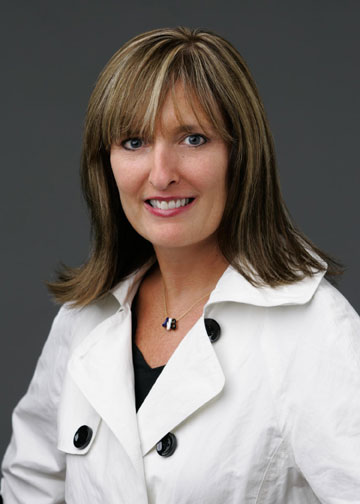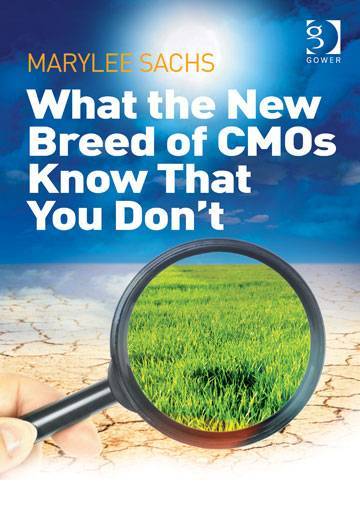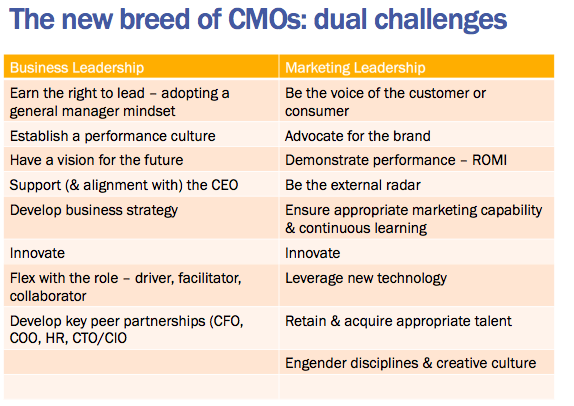
By MaryLee Sachs
Everyone thinks they are a good marketer. And yet, marketing may be the least understood business function in the C-suite by both the outside world and internal audiences. Certainly, the CMO job spec varies widely between organizations and the maturity of that organization’s marketing function. So what makes a good CMO? In today’s world where marketing and technology are converging, and where the customer reigns supreme, the CMO is becoming more important than ever.

What The New Breed of CMOs Know That You Don’t started as a research project to determine how CMOs are up-leveling their roles. This was a follow-up to my first book – The Changing MO of the CMO: How the Convergence of Brand and Reputation is Affecting Marketers. Twenty-six CMOs who were appointed to newly-created roles, or roles that had been heightened in importance, were interviewed for the book, representing a wide range of CMOs across the spectrum of B2C, B2B and some that spanned both.
Job specifications differ widely – much more than for the CEO or CFO. And the responsibilities of my interviewees varied depending on the organization, but they had two things in common: the ear and support of their CEO, and a passion for using marketing to create a change agenda in their organizations. As Guy Longworth, SVP of Playstation Brand Marketing for Sony Computer Entertainment Americas, said: “Having been a CMO in four different organizations, I have seen at first hand the dramatic changes in the role of the CMO over the last 15 years. The role continues to evolve and increase in importance….”
As we close out the year of 2013 and prepare for a new year of doubtless change, CMOs may be well-advised to take a step back and think about their agenda within their own organizations. Are they truly leveraging their creative and analytic abilities given the growing complexity of the business environment? Can they really deliver against the leap in customer centricity and consumer power?
The rapid pace of change is creating the need for a new breed of “super-hero” CMO able to demonstrate strength in communication and collaboration, fully understand both the business and the customer, and able to be agile and flexible – and yet decisive. And above all else, today’s senior marketer needs to demonstrate curiosity and an eagerness to continue to learn. Julie Woods-Moss, CMO of $4 billion technology company Tata Communications, calls this “intellectual curiosity”.
According to Woods-Moss, “Intellectual curiosity is about always be the one in the room saying: why, what about this? I think it’s a combination of intellectual curiosity and intellectual honesty.” And she added, “Don’t be afraid to say, even if it’s not in your interest, that this is not in the interest of the business. It’s this combination of intellectual curiosity with intellectual honesty.”
Call it what you like –intellectual curiosity, learning agility, staying ahead of the curve…it all adds up to keeping an open mind and continuing to innovate whenever and wherever you are able to create positive change.
When Woods was asked by the board to build a “global marketing function that included the corporate communications right through”, she was conscious that she inherited a group of highly optimized, local teams that were unaccustomed to working in a collaborative way. So instead of saying: “Okay, guys, we’re going to do a top-down plan, here we go”, she said: “Everybody continue to build your own plans. But then we’re going to have a donor and a recipient. And I’ll be looking for those who steal the most from other people’s plans and those who donate most to be stolen.”
Woods-Moss rewarded her team members with a 20 percent bonus on achieving that dynamic, which meant that instead of forcing the globalization, she was able to build a plan from the bottom-up with incentives. In that way, she was able to celebrate the champions who gave the most, as well as those who were humble enough to actually share and re-use the most.
On a much larger scale, Woods-Moss has led the development of a platform to capture idea generation on an enterprise-wide level. While Tala Communications is a global leader in the Asia-Pacific region, the company’s challenge is to build the brand around the world. According to Woods-Moss, “Where I may be able to have a couple of data scientists on my bench, and half a dozen digital experts, I can’t always have the top, top talent in every discipline. So what we’ve done is develop a platform which spans the business. We’re 480,000 people around the world – from chemicals to beverages to luxury goods. So we’ve developed this platform called Tata Innoverse. ‘In’ for innovate and ‘Verse’ for universe. And anybody in the company can throw a challenge to the Innoverse, and anyone in the company can reply.”
According to Woods-Moss, since its inception, the company has generated tens of thousands of business ideas. But what has been most interesting is of the winning ideas, 30 percent of them have not come from the function concerned. So, for example, an idea for mobile came from the beverages team. “Because we all know the secret so often in innovation is diversity in all aspects. So we’ve started this within our own family,” Woods-Moss reasoned.
On the subject of innovation and idea generation, Douwe Bergsma, CMO of privately-held FMCG company Georgia-Pacific, also spoke about innovation at the launch of the book at the Cannes Lions International Festival of Creativity. When Bergsma arrived at Georgia-Pacific, the definition of innovation and the application of innovation was predominantly product innovation. They were, in many respects, synonymous. But Bergsma was keen to take innovation beyond product. “It’s innovation of processes, innovation of marketing, innovation of packaging our graphics, our channels, the way we go to market,” he said.
“One of the largest innovation efforts we’ve made is moving into e-commerce, which has become relatively big for us in a relatively short time. But that’s guided the innovation. So we’re talking to folks like yes, you’re a brand manager, or you’re responsible for a media buy. And our question is: how are you innovating our media buy? How are you innovating our line measurements? So we’re actually innovating across the board,” he continued.
Douwe focuses on creating what he calls “restless discontent” in order to achieve innovation. “First, you need to have some discontent with the current situation. Second, you need to have a vision of a better state. And a third is to believe that there’s a reasonable path to get there,” he explained.
Setting lofty goals to be achieved by innovation in practice seems to be a common thread across change-making CMOs. SP Shukla, who is president of Group Strategy as well as chief brand officer of the Mahindra Group, described a policy for empowering the Group’s teams in order to get the best ideas.
Shukla’s Office of Strategic Management is responsible for the conduct of “war rooms,” a concept pioneered by Mahindra Group. All 18 operating businesses present their three-year strategies in one-, two-, or three-day meetings which are attended by the chairman, group CFO, group strategy head (Shukla), and several other senior colleagues from HR, finance, accounts, IT, as well as of course the business company or sector team presenting. These meetings take place from mid-October through end-December. Then, strategy is not re-opened again for one year.
Shukla says, “So they’re left alone to operationalize the agreed strategy in peace. That is true empowerment.”
These meetings are followed with “budget war rooms” in February and March – a series of mostly half-day or one-day meetings which convert the agreed strategy into annual operating plans (AOPs) with quantified goals. Any developments in markets or regulations are taken into account which might have happened since the strategy war room. Then, from July through September, the group conducts “operations war rooms” to discuss how the businesses are performing against the budgets, and any change in tactics that may be required. This is also where possible market expansion is discussed. For example, in the automotive and farm sector, Mahindra already is in the US, Australia, India, China and South Africa, but the group is looking to expand into Africa and Europe.
According to Shukla, these war rooms also provide platforms to discuss starting a new business. “We are starting new businesses all of the time. For example, Mahindra Partners, which is an incubation arm, ventured into solar energy in 2011.
When Elisa Steele was appointed to a newly-created CMO role at Skype (as well as becoming corporate vice president of marketing for Microsoft), she needed to consolidate a team of diverse functions across a number of geographies. And she wanted to build what she could see was a huge opportunity across the enterprise: story-telling.
She discovered that people love Skype. “Any great consumer brand aspires to brand love. That’s the ultimate. And it was amazing to me to find not only how much brand love Skype has with its users but how much users use that word. Even when I got this job, I got ‘Hi Elisa, I heard you’re working at Skype. I love Skype. Let me tell you my story.’ And it just happens, all of the time,” she claims.
This premise gave her the inspiration for working with the team to build a mission statement aiming to build the best relationship and collaboration between product and marketing. “It has to be memorable. It has to be inspiring, and it has to be long-lasting. And so, what we ultimately came up with is three words, and not only the team rallied around those three words, but I have product managers asking me ‘when are you getting the T-shirts?’” she states.
That mission is “Build user love”. Steele explains, “The ‘build’ is around the hard work that we want to put in because building something is not easy and it’s also a signal to the product organization that they build great products and we support you. The ‘user’ is about putting the user in everything that we know, into the center of decision-making and into our hearts of how we move forward with the brand. And then obviously the ‘love’ is what I just team up with everything else.” And this mantra informs everything in which the marketing team engages.
Steele continued by saying that the big accomplishment is that the mission is deeply believed in, and now she and her team are building off that, operationalizing it with her team and peers.
But the CMO challenge goes way beyond the marketing function. Given the ambiguities of the role, a CMO often has the toughest job of educating both the internal community as well as the external world about marketing and its primary role in building business, contributing to growth of the organization. And in order to do so, the CMO has to have one foot in the business leadership area, being a true C-suite player, and the other foot in the marketing leadership area. This presents a set of “dual challenges”.
While there are many differences in the job descriptions, the marketers taking on new CMO roles or looking to up-level current roles need to demonstrate some remarkable characteristics in. According to an article published by Marketing Management in the Spring of 2012: “The chief information officer, chief technology officer or CMO who thrives as a member of the senior leadership team will be a team player who can lead without rank and has built an organization that earns the respect of the rest of the business. The skills that are increasingly in favor are strong communication, willingness to partner and strategic thinking.
For CMOs to thrive and survive in a collaborative C-suite, they will have to adopt a general management mindset and earn the respect of the others with fact-based analyses. They will be accountable for the brand strategy, driving the organic growth agenda and positioning the business for the future. As the acknowledged voice of the customer and consumer, they will ensure the strategy is built and executed from the outside in. They can no longer be passive service providers, content to oversee market insight activities, coordinate relationships with key marketing partners and ensure compliance ‘reasonably’ with brand guidelines.”
 One of the co-authors of this article was Rob Malcolm, former president of global marketing, sales and innovation at Diageo and current lecturer at Wharton Business School. Malcolm spoke at a Conference Board CMO master class in November 2012 and stressed the dual leadership challenge for CMOs to demonstrate, first and foremost, business leadership, and then marketing leadership.
One of the co-authors of this article was Rob Malcolm, former president of global marketing, sales and innovation at Diageo and current lecturer at Wharton Business School. Malcolm spoke at a Conference Board CMO master class in November 2012 and stressed the dual leadership challenge for CMOs to demonstrate, first and foremost, business leadership, and then marketing leadership.
“The successful CMO embraces the dual business leadership and marketing leadership roles. He or she must work harder at the general business leadership role as they do at the role of leading the marketing because these are the newer challenges that they are less well prepared for. Too often CMOs focus on the marketing role only and this is to their peril. They need to establish their executive/business/leadership credentials as priority number one, and have a concrete strategy to do so,” Malcolm said.
All of the CMOs interviewed for the book demonstrated these characteristics. Several brought experience in operational roles to their marketing positions, bringing a new level of business acumen and fluency to the practice of marketing in their organizations.
Other common strengths included the strong desire to collaborate across the enterprise, a fearlessness to experiment and learn from both success and failure, a dedication to soliciting creativity and innovation from all employees—not just those in the marketing department, and a passion for recruiting, developing and retaining the best talent.
Interestingly, these CMOs are remarkably aligned on the importance of culture in the organization, and the role they can play in helping to shape a positive and productive mindset. But the CMO role is increasingly not for the faint of heart. The CMO role continues to morph – the world is changing, what they’re facing is changing; nothing remains constant.
MaryLee Sachs is an independent marketing consultant who has written two books on CMOs: The Changing MO of the CMO: How the Convergence of Brand and Reputation Has Affected Marketers, launched at the Cannes Lions International Festival of Creativity in 2011; and What the New Breed of CMOs Know That You Don’t which was launched at Cannes this year (2013). She established her consultancy, Changing MO LLC, in 2012, based on the tenets of her first book. As for former global head of consumer marketing at a major WPP firm, she has spent the last seven years focused on the CMO community and has contributed to both The CMO Club and the Marketing 50 as an advising member. MaryLee can be reached at 917-478-8744; marylee@changingmo.com; and @maryleesachs

